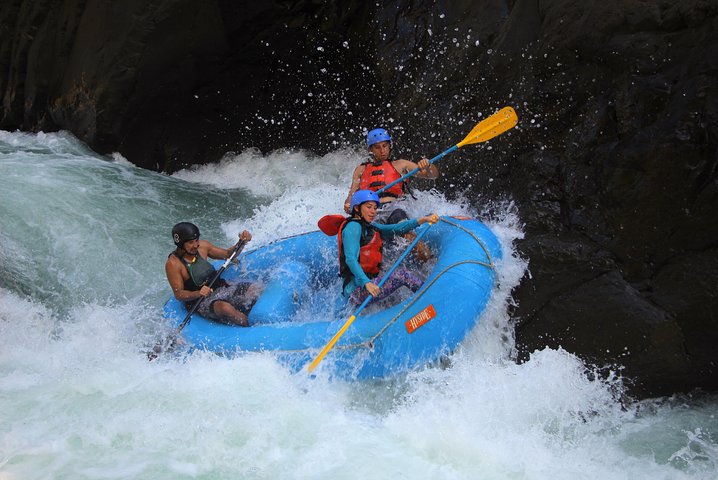Chorro on the Edge: Running Costa Rica’s Naranjo River Through a Canyon of Drops
A tight-canyon, Class IV–V run near Quepos that pairs rainforest scenery with full-throttle rapids
The raft nose bobs, then drives into a wall of water: a brief, violent inhale of the Naranjo River that throws spray into your face and leaves you laughing in a voice washed raw by adrenaline. Around you the canyon narrows, granite boulders crowd the channel like the teeth of some patient beast, and the rainforest presses close — orchids and ferns clinging to damp rock faces, a cascade somewhere upstream that seems to be daring you to look away. For 90 minutes of river time on the Chorro section, the world reduces to the rhythm of paddling, the guide’s commands, and the current that always, insistently, wants you downstream.
Trail Wisdom
Expect strong flows
Chorro runs Class IV–V rapids; higher water in the rainy season makes lines faster and more technical — follow the guide’s commands exactly.
Secure footwear
Wear closed-toe water shoes or old trail runners with good grip so they don’t float off if you swim.
Protect electronics
Use a small waterproof case or leave cameras with the photographer; phones in dry bags are the safest option.
Fuel up and hydrate
Bring water and eat a light breakfast — the trip includes lunch but the exertion is immediate once you hit the river.
Local Knowledge
Hidden Gems
- •Early-morning birding in the mangrove estuary near Quepos for scarlet macaw and heron sightings
- •Sodas in Manuel Antonio serving fresh ceviche and casados — perfect post-raft refuel spots
Wildlife
White-faced capuchin monkey, Two-toed sloth
Conservation Note
Responsible operators minimize riverbank disturbance, hire local guides, and practice Leave No Trace; bringing reef-safe sunscreen and packing out trash helps protect freshwater and coastal ecosystems.
The rivers of Costa Rica’s Central Pacific have long shaped local communities; modern adventure tourism developed here alongside conservation efforts to balance livelihoods and habitat protection.
Seasonal Guide
spring
Best for: Shoulder-season water levels, Fewer crowds, Combining with beach time
Challenges: Transition rains possible, Variable river flows
Spring (April–May) can be a transitional window: flows increase but may not be at peak; good for pairing rafting with other activities.
summer
Best for: Higher water and big rapids, Lush rainforest scenery
Challenges: Frequent heavy afternoon rains, Muddy access roads at times
Summer/wet season (May–November) brings the strongest, most technical river conditions — ideal for experienced paddlers.
fall
Best for: Peak river runs late in season, Dramatic river features
Challenges: More unpredictable storms, Possible cancellations in extreme weather
Late rainy season yields powerful, exciting rapids but keep an eye on weather forecasts and operator advisories.
winter
Best for: Calmer water lines, Easier conditions for less-experienced rafters
Challenges: Lower flows reduce some rapid features, Clearer skies can mean stronger sun exposure
Dry season (December–March) typically softens the run — good for those wanting a less aggressive whitewater experience.
Photographer's Notes
What to Bring
Closed-toe water shoesEssential
Stay secure if you enter the water — flip-flops or sandals can float away and are unsafe around rocks.
Quick-dry clothing (rash guard or synthetic shirt)Essential
Dries quickly after swims and protects from sun and brush during shuttles.
Small dry bag or waterproof phone caseEssential
Protects electronics and valuables from spray and potential immersion.
Reef-safe sunscreen & insect repellent
Protects skin without harming aquatic or coastal ecosystems; useful in humid, sunny spells.
Common Questions
What is the minimum age or fitness requirement?
This run is recommended for people in strong physical condition; specific age or weight limits depend on the operator — check at booking for minimum age and medical restrictions.
Is transportation included from Manuel Antonio or Quepos?
Yes — A/C hotel pick-up and drop-off from Manuel Antonio or Quepos are included in the tour price.
Will I get photos from the trip?
A photographer accompanies the trip and photos are available for purchase after the excursion.
What safety measures are in place on Class IV–V runs?
Trips include certified bilingual guides, safety kayakers, helmets, and PFDs; a full safety briefing precedes launch and guides manage risk on technical rapids.
How long is the rafting portion versus the full tour?
The total tour is about 4.5 hours from pickup to drop-off, with roughly 1.5 hours spent actively rafting on the river.
What happens if it rains or the river is too high?
Operators monitor river conditions closely and may reschedule or cancel for safety; many tours offer free cancellation or rebooking in extreme weather.
What to Pack
Water shoes (secure footing), quick-dry shirt (sun & comfort), waterproof phone case (photos), small snack and water bottle (energy and hydration)
Did You Know
Manuel Antonio and the Quepos corridor are globally renowned for accessible wildlife viewing — white-faced capuchin monkeys and two-toed sloths are commonly seen in nearby reserves and along river corridors.
Quick Travel Tips
Fly into San José (SJO) or regional Quepos (XQP); allow 1–2 hours driving from San José; expect limited cell service in the canyon; confirm hotel pickup time the night before
Local Flavor
After the river, head to a local 'soda' in Manuel Antonio for a casado (rice, beans, protein and salad) or fresh ceviche; many small bars serve Costa Rican craft beers and are happy to swap river stories with you.
Logistics Snapshot
Closest major airport: Juan Santamaría Intl. (SJO). Regional airport: Quepos/Manuel Antonio (XQP). Typical drive from San José: 2.5–3 hours. Hotel pickup: included from Quepos/Manuel Antonio. Cell service: patchy in canyon. Permits: none for visitors; operator covers required local permissions.
Sustainability Note
This river corridor is ecologically sensitive — choose operators who hire local guides, avoid single-use plastics, use reef-safe sunscreen, and pack out all waste to protect freshwater and coastal habitats.
